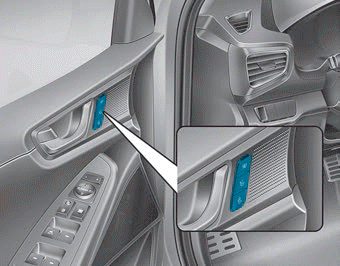Hyundai Ioniq: Cylinder Block / Cylinder Block. Repair procedures
Hyundai Ioniq (AE) 2017-2025 Service Manual / Engine Mechanical System / Cylinder Block / Cylinder Block. Repair procedures
| Disassembly |
|
|
|
| 1. | Remove the engine assembly from the vehicle. (Refer to Engine and Transaxle Assembly - "Engine and Transaxle Assembly") |
| 2. | Remove the transaxle assembly from the engine assembly. (Refer to Double Clutch Transmission (DCT) System - "Double Clutch Transmission (DCT)") |
| 3. | Remove the flywheel. (Refer to Cylinder Block - "Flywheel") |
| 4. | Remove the rear oil seal. (Refer to Cylinder Block - "Rear Oil Seal") |
| 5. | Install the engine to engine stand for disassembly. |
| 6. | Remove the intake manifold. (Refer to Intake and Exhaust System - "Intake Manifold") |
| 7. | Remove the exhaust manifold. (Refer to Intake and Exhaust System - "Exhayst Manifold") |
| 8. | Remove the hybrid starter generator (HSG). (Refer to Hybrid Motor System - "Hybrid Starter Generator (HSG)") |
| 9. | Remove the timing chain. (Refer to Timing System - "Timing Chain") |
| 10. | Remove the cylinder head assembly. (Refer to Cylinder Head Assembly - "Cylinder Head") |
| 11. | Remove the thermostat. (Refer to Cooling System - "Thermostat") |
| 12. | Remove the EGR cooler. (Refer to Intake and Exhaust System - "EGR Cooler") |
| 13. | Remove the A/C compressor. (Refer to Heating, Ventilation Air conditioning -"Compressor") |
| 14. | Remove the knock sensor. (Refer to Engine Control / Fuel System - "Knock Sensor") |
| 15. | Remove the oil pan and oil screen. (Refer to Lubrication System - "Oil Pan") |
| 16. | Remove the ladder frame. (Refer to Cylinder Block - "Piston and Connecting Rod") |
| 17. | Remove the piston and connecting rod assemblies. (Refer to Cylinder Block - "Piston and Connecting Rod") |
| 18. | Remove the crankshaft. (Refer to Cylinder Block - "Crankshaft") |
| 19. | Remove the crankshaft position sensor (CKPS). (Refer to Engine Control / Fuel System - "Crankshaft Position Sensor (CKPS)") |
| 20. | Remove the oil pressure switch. (Refer to Lubrication System - "Oil Pressure Switch") |
| 21. | Remove the water jacket separator. (Refer to Cylinder Block - "Water Jacket Separator") |
| 22. | Remove the piston cooling jet (A).
|
| Inspection |
Cylinder Block
| 1. | Remove the gasket material. Using a gasket scraper, remove all the gasket material from the top surface of the cylinder block. |
| 2. | Clean the cylinder block. Using a soft brush and solvent, thoroughly clean the cylinder block. |
| 3. | Inspect the top surface of the cylinder block for flatness. Using a precision straight edge and feeler gauge, measure the surface contacting the cylinder head gasket for warpage.
|
| 4. | Inspect the cylinder bore. Visually check the cylinder for vertical scratchs. If deep scratchs are present, replace the cylinder block. |
| 5. | Inspect the cylinder bore diameter. Using a cylinder bore gauge, measure the cylinder bore diameter at position in the thrust and axial direction.
|
| 6. | Check the cylinder bore size code on the cylinder block.
Discrimination of cylinder bore size
|
| Reassembly |
|
| 1. | Install the piston cooling jet (A).
|
| 2. | Assemble the other parts in the reverse order of disassembly.
|
 Crankshaft. Repair procedures
Crankshaft. Repair procedures
Disassembly
•
Be sure to read and follow the "General Safety Information and Caution" before doing any work related with the high voltage system...
Other information:
Hyundai Ioniq (AE) 2017-2025 Service Manual: DCT (Dual Clutch Transmission). Components and components location
Components (1)1. Dual clutch transmission assembly2. Hybrid motor assembly3. Gear actuator4. Clutch actuator5. Engine clutch actuator6. Reserver7. Dust cover8. Support bracket mounting bolt9. DCT (Dual Clutch Transmission) support bracket10. Roll rod support bracket11...
Hyundai Ioniq (AE) 2017-2025 Service Manual: Front Door Window Glass. Components and components location
C..
Categories
- Manuals Home
- 1st Generation Ioniq Owners Manual
- 1st Generation Ioniq Service Manual
- Child-Protector Rear Door Locks
- Auto Door Lock/Unlock Features
- Check brakes/Check regenerative brakes, Check Virtual Engine Sound System
- New on site
- Most important about car
Driver Position Memory System

The Driver Position Memory System is provided to store and recall the following memory settings with a simple button operation.
- Driver's seat position
- Side view mirror position
- Instrument panel illumination intensity
Copyright © 2025 www.hioniqae.com









